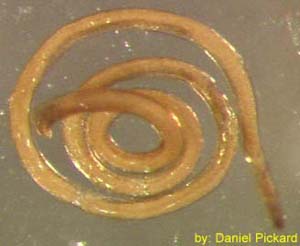| |
Nematodes, or roundworms, live everywhere on land and water. The most notorious nematodes are the parasitic and predatory species that are sometimes of great economic and health concern to humans, including the human parasite hookworm.
Freshwater nematodes inhabit a variety of water bodies and have adaptations for eating everything from plants to detritus to other animals. The freeliving aquatic species are largely ignored by scientists, though they are sometimes numerous in freshwater macroinvertebrate samples. They are often smaller than the parasitic nematodes, which are found more frequently in standard macroinvertebrate samples.
Aquatic nematodes are long, tubular, unsegmented worms that are usually white, gray, or clear. The anterior end of the body is rounded or blunt, and the posterior end tapers to a point. Identifying parasitism may be of interest in other types of studies, but it is not typically a goal of standard macroinvertebrate monitoring. Nematodes that are emerging from or still inside a host organism are not counted as individuals in a sample.. |
|
Size: xsmall to medium
Identifying feature(s): tubular, unsegmented; parasitic forms may be observed emerging from or associated with a macroinvertebrate host
Habitat: widepsread
Tolerance: tolerant
|


